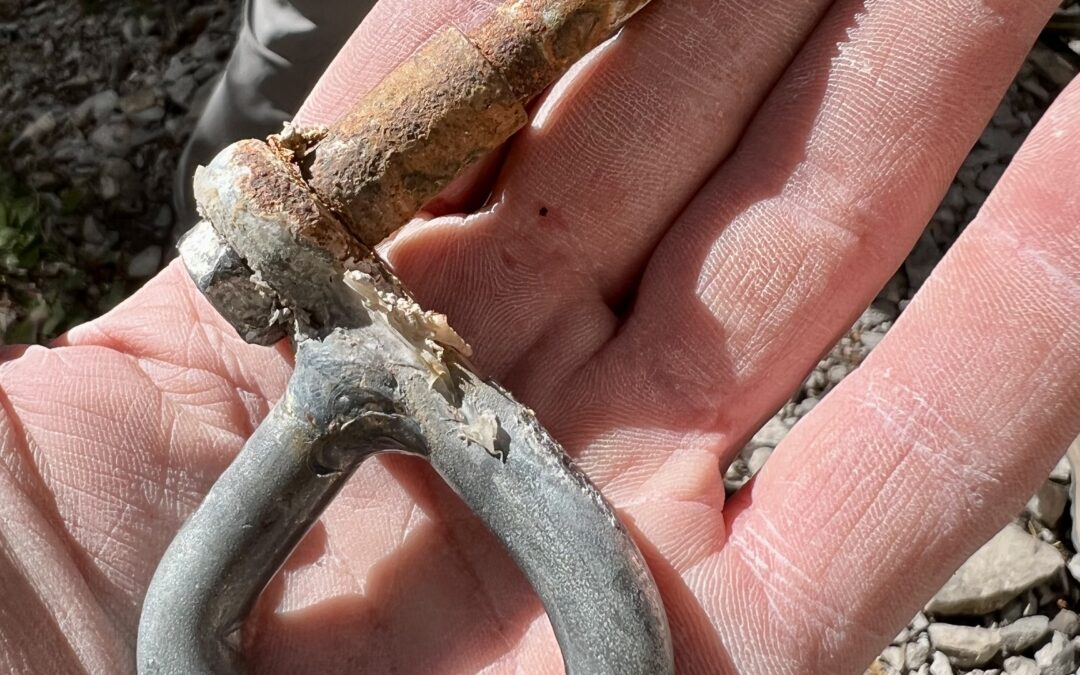That bolt you’ve been whipping on while trying to send your project at Upper Blacktail Butte? Good news: it’s going to hold your fall.
That wasn’t necessarily the case earlier this autumn.
On October 15, the second phase of the TCC’s Climbing Area Modernization (CAM) Project got under way with the replacement of more than three dozen bolts and anchors at Blacktail Butte.
What the volunteers found wasn’t always pretty.
“Probably half the routes we replaced had rusted quarter-inch bolts,” said TCC board member and CAM Project coordinator Garrick Hart. “On one chain link anchor, the bolts extended only an inch into the rock. They should have extended three inches.”
The CAM Project is a multi-year undertaking to monitor, inspect and replace aging hardware at climbing areas throughout the Jackson Hole area. The project kicked off in late September, when volunteers replaced roughly 50 bolts and installed new, drop-in anchors at Upper Blacktail Butte, a cragging area within Grand Teton National Park boundaries.
The Blacktail Butte work is being done under a National Park Service Special Use Permit that prohibits drilling new holes. Volunteers are utilizing the TCC’s “best practices” guideline for new route development to inform replacement strategies.
In October, Hart and fellow TCC board members Charlie Thomas and Morgan McGlashon were joined by Nat Patridge, Matt Floyd and Hans Johnstone to continue the Blacktail Butte work. All volunteers are Exum mountain guides.
“We pulled all hardware that was plated steel and replaced it with glue-in bolts using the same hole,” Hart said. “We inspected all the routes and left only the stainless steel stud bolts that were in good condition.”
According to Garrick, the most disturbing part of the project was the uncertainty.
“We didn’t know what we were going to get until we pulled a bolt,” he said. “That was the frightening part: some of the ones we pulled were fine, while others were scary. But they all looked the same until we pulled them.”
The process has turned out to be more labor intensive than originally anticipated, in part because of the emphasis on quality, sustainable work.
“It takes an enormous amount of time and work to get the old corroded steel out of the hole so that we could re-use the hole,” said Hart continued. “By using the same hole, we’re taking the several-hundred-year perspective. If we simply pulled a suspect bolt, patched the hole and drilled a new hole for the new bolt, the process would be easier. But if we did that, some of the routes would already have three holes per bolt, even though the routes are only 30 or 40 years old. That’s not very sustainable in the long run.”
Despite the slow pace, Hart is hopeful that work will go more quickly in the future. “We’ve learned a lot about pulling and efficiency,” he said. “A small investment in equipment would double our efficiency.”
The CAM Project is being funded by donations from the community using hardware provided by The American Safe Climbing Association. Those interested in supporting the project may do so via tax-deductible donations to the TCC.
Please click here to donate now.
“The most important thing we’ve learned to date,” said Hart, “is that establishing a route right the first time is key. Any new route should be bolted according to modern standards. It’s a thousand times easier to establish a route correctly than it is to rebolt it later if the hardware corrodes prematurely.”
To date, the CAM Project has replaced nearly 100 bolts and anchors on nine routes on the Crackin’ the Cherry and Rock Candy Nugget walls. Six additional routes on Rock Candy Nugget Wall remain to be inspected.
The work at Blacktail Butte is expected to be completed by 2024. Additional Jackson Hole climbing areas, including Rodeo Wall, Hoback Shield and the Happy Hour Wall, will be addressed as part of the CAM Project in upcoming summers.
Routes inspected/replaced to date are as follows:
Crackin’ the Cherry Wall (from right to left):
- Tec DC-9 (5.10c)
- Muy Macho (5.10d)
- Crackin’ the Cherry (5.11a)
- Runnin’ Down a Dream (5.13b)
- Blitzkrieg (5.11d)
- Red Chili (5.9)
Volunteers did not work on Mac 10 (5.10d R), as it requires additional bolts that are not allowed under the permit.
On the short tower in between Crackin the Cherry Wall and Rock Candy Nugget, volunteers replaced the hardware on:
- Civil Disobedience (5.9)
- Power Trip (5.10a)
On the Rock Candy Nugget wall, they replaced the hardware on Americana (5.12a).

